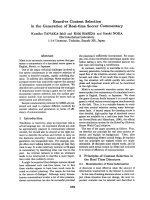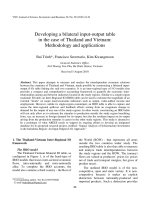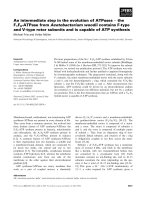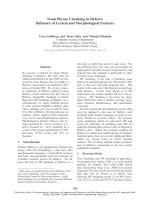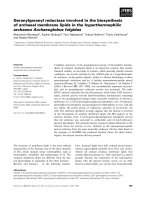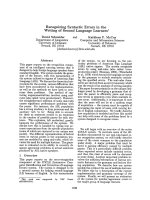Báo cáo "Developing a bilateral input-output table in the case of Thailand and Vietnam: Methodology and applications " doc
Bạn đang xem bản rút gọn của tài liệu. Xem và tải ngay bản đầy đủ của tài liệu tại đây (243.62 KB, 13 trang )
VNU Journal of Science, Economics and Business 26, No. 5E (2010) 24-36
24
Developing a bilateral input-output table
in the case of Thailand and Vietnam:
Methodology and applications
Bui Trinh*, Francisco Secretario, Kim Kwangmoon
General Statistics Office,
No2 Hoang Van Thu, Ba Dinh, Hanoi, Vietnam
Received 5 August 2010
Abstract. This paper attempts to measure and analyze the interdependent economic relations
between the countries of Thailand and Vietnam, made possible by constructing a bilateral input-
output (I-O) table linking the said two countries. It is an inter-regional type of I-O models that
provides a compact and comprehensive accounting framework to quantify the economic inter-
relationships among and between industries located in the study regions. Similar to a single-region
(national) IO table, an Inter-Regional IO (IRIO) table can be used to estimate the magnitude of an
external “shock” on major macroeconomic indicators such as output, value-added, income and
employment. However, unlike its single-region counterpart, an IRIO table is able to capture and
assess the inter-regional spillover and feedback effects arising from an exogenous change in
demand for the output of any one of the study regions. In other words, constructing an IRIO table
will not only allow us to estimate the stimulus to production outside the study region benefiting
from, say, an increase in foreign demand for its output, but also the resultant impact on its output
arising from the production stimulus it causes in the other study regions. This study is deemed to
be a prototype of what AREES needs to support its ongoing efforts to develop an integrated
database for its proposed research project, entitled: “Impact Analysis of Infrastructure Investment
in the Indochina Region: An Input-Output (I-O) Approach.”
1. The Thailand-Vietnam Inter-Regional IO
framework
*
The IRIO model
The Thailand-Vietnam bilateral IO table, as
configured in Figure 1, is of the Isard-type of
IRIO models that traces inter-sectoral economic
flows, intra-nationally and inter-nationally
alike. To complete the IRIO accounts, the
model also contains a third country - the Rest of
______
* Corresponding author. Tel: 84-01259370026
E-mail:
the World (ROW) - that represents all areas
outside the two countries under study. The
resulting IRIO table is also thus able to measure
and analyze trade interdependencies between
the study regions and the ROW. The (money)
flows are valued at producers’ prices (ie, prices
net of trade and transport margins, but gross of
product taxes).
The outlined IRIO model is of the non-
competitive, open and static variety. It is non-
competitive because it makes an explicit
distinction between nationally-produced and
imported products. Such a distinction provides
B. Trinh et al. / VNU Journal of Science, Economics and Business 26, No. 5E (2010) 24-36
25
a better reflection of the use of domestic
production technology and inputs in the
production of output in each country. The
“openness” of the model is derived from the
fact that economic activities are split into the
intermediate and final demand categories. The
transactions in the former category can be
explained by the model, while the latter
category contains exogenous transactions which
must be initially known or given. The static
nature of the model is a consequence of the
absence of a time dimension from it, i.e. the IO
transactions relate to the selected fixed period,
which, in this case, is calendar year 2000.
Source: Authors
Balance and structural equations
A system of IRIO tables is balanced, implying
that the supply and demand sides are equal. Using
Figure 1, this equality can be translated into the
following accounting identities:
(1)
T
X
=
′
T
X
, (ie, column vector of gross outputs
of Thailand’s products is equal to row vector of
gross inputs of Thailand’s production sectors);
V
X
=
′
V
X
, (ie, column vector of gross outputs of
Vietnam’s products is equal to row vector of gross
inputs of Thailand’s production sectors).
(2)
.
V
∑
=
.T.VWW
FFEM
++−
ΣΣ
∑
, (ie,
sum of the two economies’ value added or
gross domestic product (GDP) is equal to the
two economies’ total final demands).
Figure 1 can also be used to form the
following balancing equations in matrix form:
TTTTVTTTVTW
XXiXiFFE
=++++
(1)
VVTVVVTVVVW
XXiXiFFE
=++++
(2)
In both equations, represents a column
vector of appropriate ones. The first term on the
right hand side of equation (1) represents
intermediate consumption of products of
Thailand by its (Thailand’s) own production
sectors, the second term denotes the trade flows
of products of Thailand to Vietnam for
intermediate consumption, the third and fourth
terms represent the sales of the output of Thailand
to its own final domestic demand and Vietnam
respectively, while the last term represents the
exports of Thailand to the ROW, i.e. all areas
outside the bi-nation’s territorial limits. An
analogous explanation applies to equation (2).
Using Leontief’s assumption of linearity or
first-order homogeneity in the production
functions, we can define the following national
input coefficients in matrix form:
(
)
TTTTT
ˆ
AXX
−
=
1
(3)
B. Trinh et al. / VNU Journal of Science, Economics and Business 26, No. 5E (2010) 24-36
26
(
)
TVTVV
ˆ
AXX
−
=
1
(4)
(
)
VTVTT
ˆ
AXX
−
=
1
(5)
(
)
VVVVV
ˆ
AXX
−
=
1
(6)
Equations (3) and (6) represent the matrices
of intra-national direct input coefficients, while
equations (4) and (5) stand for the matrices of
inter-national trade coefficients. Substituting
these structural equations into equations (1) and
(2), we have:
TTTTTVVTTTVTW
XAXAXFFE
=++++
(7)
VVTTVVVVTVVVW
XAXAXFFE
=++++
(8)
Combining equations (7) and (8), we have:
TTTTVTT
VVTVVVV
XAAXY
XAAXY
=+
(9)
where
TTTTVTW
YFFE
=++
and
VVTVVVW
YFFE
=++
.
Simplifying equation (9), we have:
1−
=−=
TTTTVTTTTVT
VVTVVVVTVVV
XI0AAYLLY
0I
XAAYLLY
(10)
Equation (10) can be further simplified and
shown its generalized form as:
=
XLY
(11)
where
X
is the matrix of national outputs,
T
V
X
X
;
Y
is the matrix of national final demands,
T
V
Y
Y
;
and
L
is the inter-national Leontief inverse
matrix,
TTTV
VTVV
LL
LL
.
The Leontief inverse matrix,
L
, is a table of
multipliers that links production,
X
, and final
demand,
Y
. In this case study, it shows the total
(direct plus indirect) outputs in both Thailand
and Vietnam that are needed to sustain unit
changes in their respective final demands. The
inverse matrix is the most important table
needed in inter-national input-output analysis as
it unravels the inter-national, inter-industrial
dependencies brought about by the repercussive
effects of changes in final demands.
In order to be able to measure the spillover
and feedback effects due to inter-regional
(national) trade, Round (2001) decomposed the
Leontief inverse, thus rewriting equation (10)
into the following form:
TT
TTVT
VVTV
VV
I
XY
FSM
FSIM
XY
=
00
00
(12)
where:
(
)
TTT
MIA
−
=−
1
TVTTV
SMA
=
(
)
TTVVT
FISS
−
=−
1
(13)
(
)
VVV
MIA
−
=−
1
VTVVT
SMA
=
(
)
VVTTV
FISS
−
=−
1
M accounts for the intra-regional linkages,
while S and F show the inter-regional spillover
and feedback effects, respectively.
2. Main results and applications
This section describes and explains the key
results and applications of the study. A
comparison of the economies of both countries
is made first, before the findings of applications
such as multiplier, linkage and impact analyses
as well as spillover and feedback effects are
presented and analyzed. For the purpose of this
paper, the results are presented based on the IO
tables for 14 production sectors, which are
further aggregated into three major sectors,
where appropriate.
(1)
Output Multipliers
Presented in Table 1 are estimated total
(direct and indirect) output multipliers,
calculated from the bilateral IRIO table’s
Leontief inverse. The column sums of the IRIO
inverse represent the total outputs that
producing sectors have to produce in order to
sustain a unit demand of their products. For
example, in order to satisfy 1000 units of demand
for crops, livestock & poultry products by both
Thailand and Vietnam, Thailand’s economy needs
to produce 1,511 units of output, out of which
______
(1)
The table mapping the countries’ basic sector
classifications into the 14-sector and 3-major sector
aggregations used in this study is presented in Annex A.
B. Trinh et al. / VNU Journal of Science, Economics and Business 26, No. 5E (2010) 24-36
27
1000 units goes to the crops, livestock & poultry
sector itself and the residual 511 units to sustain
the direct and indirect demand by other sectors in
both Thailand’s and Vietnam’s productive
economies.
Ranked in descending order, Table 1
indicates that the extent of interdependencies
between the production sectors in Thailand’s
economy is observed to be relatively more
intense than in Vietnam’s. Evidently, 9 sectors
in Thailand exhibited total output multipliers
ranked in the upper half of the 28-sector ladder
against 5 in Vietnam. The food, beverage &
tobacco sector of Vietnam exhibited the highest
output multiplier effect of 2.016, followed by
Thailand’s transport services (12) and food,
beverage & tobacco (05) sectors with output
multiplier effects of 1.995 and 1.966,
respectively. This finding indicates that these
sectors are relatively the heaviest intermediate
consumers of domestically-produced outputs,
while their dependencies on imported inputs are
observed to be relatively low.
The top bottom three, in terms of total
output multipliers, all belongs to Vietnam’s
post & telecommunication (13), electricity, gas,
steam & water (09) and logs & forest products
(02) with TOMs of 1.16, 1.19 and 1.20,
respectively. These sectors are least users of
intermediate inputs, with most of their material
purchases coming from the ROW, as can be
observed in Table 3B.
Table 1: Total output Multipliers
hk
Backward and Forward Linkages
Linkages reflect the dependence of industries
on one another in an economy and measure the
potential stimulus that will be induced in other
industries arising from an increase in activity in a
particular industry. In essence, there are two types
of linkages, namely, backward linkages and
forward linkages.
A backward linkage is a measure of the
relative importance of an industry as a user of
inputs from the entire production system. It
measures the output increases which will occur
in industries which supply inputs to the industry
concerned. A backward linkage can be
computed as the ratio of the sum of the
elements of a column of the Leontief inverse to
the average of the whole system. This ratio is
described by Rasmussen (1957) as the index of
the power of dispersion,
j
µ
, and is defined
mathematically as.
1
11
1
l
l
n
ij
i
j
nn
ij
ij
n
=
==
µ=
∑
∑∑
(14)
B. Trinh et al. / VNU Journal of Science, Economics and Business 26, No. 5E (2010) 24-36
28
where the
l
ij
is the element of the inter-regional
Leontief inverse. The higher the value of
j
µ
, the
stronger is the influence of production sector j as a
user of intermediate inputs.
A forward linkage indicates the relative
importance of an industry as a supplier of
inputs to the entire production system. It
measures the output increases which will occur
in industries which use the inputs supplied by
the industry concerned. A forward linkage can
be expressed as the ratio of the sum of the
elements along a row of the Leontief inverse to
the average of the entire system. This ratio is
described by Rasmussen (1957) as the index of
sensitivity,
i
µ
, and is defined mathematically as
1
11
1
l
l
n
ij
j
i
nn
ij
ij
n
=
==
µ=
∑
∑∑
(15)
The higher the value of, the greater is the
influence of production sector i as a supplier of
intermediate inputs to the entire production system.
The estimated inter-regional linkages in our
study are presented in Table 2. As can be seen,
the estimated values of the backward and
forward linkages in both countries appear to be
relatively quite low, when compared to linkage
effects of more developed economies.
Table 2: Inter-regional Backward and Forward linkage effects, 2000
Source: Authors presented at AREE conference at Laos University, March,2010
Only half of the 14 industries in Thailand
and 5 industries in Vietnam had values for
backward linkages greater than one in 2000. In
the case of forward linkages, 8 industries in
Thailand and 5 in Vietnam had values higher
than one. One likely reason for these rather low
values could be the high reliance of both
countries on the outside world (ROW) for their
supply requirements.
Spillover and Feedback Effects
A single-region IO table essentially
assumes that imports from suppliers and
exports to buyers outside the economy are
treated as exogenous. However, such a table
will not allow us to capture the interregional
economic spillover and feedback effects in an
economic system. These effects can be
B. Trinh et al. / VNU Journal of Science, Economics and Business 26, No. 5E (2010) 24-36
29
illustrated as follows. Suppose there is an
increase in demand by the ROW for the
products of the manufacturing industry in
Thailand. This will result in an increase in the
output of the manufacturing industry in
Thailand, which could result in an increase in
demand for relevant inputs from suppliers
outside the country, say, Vietnam. This new
demand for the output of the suppliers in
Vietnam will create an increase in their output
and, directly and indirectly, the output of other
industries in Vietnam. This stimulus of new
output in Vietnam due to new output in
Thailand is known as the interregional spillover
effect. In addition, suppose that the stimulated
production in Vietnam includes increased
output of industries that use inputs from
Thailand in their production process. Thus, the
increased manufacturing production in Thailand
leads to increased output of its suppliers in
Vietnam, which, in turn, leads to more
production in Thailand. This is known as the
interregional feedback effect. These
interregional effects can be measured within the
context of an IRIO table.
This sub-section quantifies the spillover and
feedback effects due to interregional trade in
products to sustain regional final demands.
Table 3 shows that, because of weak inter-
regional (national) linkages among and between
sectors, the estimated spillover and feedback
effects appear to be insignificant
(2)
.
Table 3: Inter-National Spillover & Feedback Effects, 2000
Source: AREE conference at Laos University, March,2010
(2)
Table 3 shows that the average spillover
effect of Thailand’s productive economy due to
its trade transactions with Vietnam is estimated
to be a mere US$25 for every US$1000
increase in final demand, while the estimated
spillover effect of Vietnam’s production sectors
as the result of its trade transactions with
Thailand is observed to be negligible at US$1
per US$1000 increase in final demand.
______
(2)
These spillover and feedback effects were computed
from the matrices STV and SVT, and FT and FV in
equation (12).
Spillover effects are seen to be higher for
Thailand’s manufacturing sectors of industrial
materials (07) and capital goods (08) with
US$75 and US$37 spillover effects,
respectively. Feedback effects in both regions are
found to be very negligible. The results indicate
that both countries rely heavily, not on each
other’s produce, but on the ROW for products
used in production and for final consumption.
Impact Analysis
Final demand for products has repercussive
effects on the economy. In the first round, an
increase in demand for a product of a particular
B. Trinh et al. / VNU Journal of Science, Economics and Business 26, No. 5E (2010) 24-36
30
sector will require additional output
requirement for that sector. Subsequently, the
first-order increases in output would require
further inputs to generate them. The increased
demand therefore translates to an increase in
output, which in turn result to increases in
income of the sectors involved and so on. These
total multiplier effects of final demand for
goods and services on economies are best
measured through I-O analysis.
Given the I-O table’s Leontief inverse, it is
possible to quantify the direct as well as the
indirect effects of changes in exogenous final
demand on such economic variables as output,
income, employment and import requirements.
This sub-section quantifies the impact of the
different components of final demand on these
macroeconomic indicators.
Impact on Production
The calculation of total (direct + indirect)
outputs required to sustain final demands is
carried out using equation (11) in its
generalized form, as follows:
=
XLY
(16)
where
X
is the matrix of national outputs,
T
V
X
X
;
Y
is the matrix of national final demands,
T
V
Y
Y
;
and
L
is the inter-national Leontief inverse
matrix,
TTTV
VTVV
LL
LL
; superscripts T and V denote
bilateral countries, Thailand and Vietnam,
respectively.
Table 4 summarizes the impact of final
demand on production for the 3 major sectors for
2000. The row entries in the table describe how
sectoral output is induced by each type of final
demand in both countries. Conversely, the column
entries in the table record the breakdown of
sectoral output required from both countries to
satisfy the needs of each type of final demand in
one country. The column sums can be interpreted
to be the total output induced by each type of final
demand in each country.
It can be observed from Table 4 that, of the
combined production of US$367.85 billion in
both countries in 2000, 81.5% was induced by
Thailand’s total final demand, broken down into:
37.9% by final consumption demand, 9.4% by
capital formation or investment demand and
34.2% by its exports demand. The remaining
18.5% of total production was induced by
Vietnam’s total final demand, broken down into:
8.1% by its final consumption demand, 3.4% by
capital formation and 6.9% by exports demand. It
can thus be concluded that, in both countries, total
output requirements were primarily induced by
final consumption demand, followed by the
demand for exports. Total induced output to meet
capital formation or investment demand in both
countries registered the least contribution ratios
since their domestic demands rely heavily on
supplies from the ROW.
By sector, it can be seen that, in both
countries, the bulk of output requirements for
the major sectors of agriculture, fishery &
forestry and services were induced by final
consumption, while outputs in industry was
induced largely by export demand. In
conjunction with this finding, Table 4 also
shows that Thailand’s reliance on Vietnam’s
products to sustain its (Thailand’s) final
demand is less than Vietnam’s dependence on
Thailand’s products. In 2000, Thailand
imported from Vietnam US$0.61 billion worth
of goods and services against US$1.46 billion
worth imported by Vietnam from Thailand.
From Table 4, it is also possible to determine
the total output inducement coefficients or
multipliers resulting from domestic final demands
in both countries. It can be observed that, in
Thailand, average output requirement to satisfy
final consumption demand exhibited the highest
multiplier effect of 1.692 per unit of FCE,
followed by investment demand (1.631) and
export demand (1.581). In Vietnam, it is the
demand for investment goods and services that
showed the highest output multiplier effect of
1.639, followed by FCE and export demands with
output multipliers of 1.567 and 1.530,
respectively.
B. Trinh et al. / VNU Journal of Science, Economics and Business 26, No. 5E (2010) 24-36
31
Table 4. Total (direct and indirect) impact on Production
Abbreviations: FCE: Final Consumption Expenditure; GCF: Gross Capital Formation; TFD: Total final Demand;
AFF: Agriculture, Fishery & Forestry.
Impact on Value Added
In inter-regional analysis, the value added
or income induced by the components of final
demand can be calculated using the matrix
equation:
VBLYBX
==
(17)
where
V
is the matrix of value added induced
by final demand; and
B
is matrix of value
added or primary input coefficients.
Table 5, which presents the impact of final
demand on the various factors of production for
2000, shows that 81.1% of the total GDP
generated by the 2 economies totaling
US$160.1 billion was induced by Thailand’s
final demand and the remaining 18.9% by
Vietnam’s final demand. Of the total labor
income of US$57.2 billion, 70.1% was induced
by Thailand’s final demand and 29.9% by
Vietnam’s final demand, while 89.9% of the 2
economies’ operating surplus was induced by
Thailand’s final demand, with the residual
10.1% by Vietnam’s final demand.
Approximately three-fourths (74.6%) of total
net indirect tax payments generated in both
economies was induced by Thailand’s final
demand and the remaining 25.4% was induced
by Vietnam’s final demand.
The above findings intuitively suggest that,
comparatively, Vietnam’s economy in 2000
was more labor intensive than Thailand’s, while
Thailand’s economy was more profit-oriented
than Vietnam’s. Moreover, Vietnam’s economy
appeared to be more intense than Thailand’s in
terms of production tax generation. (GVA)
B. Trinh et al. / VNU Journal of Science, Economics and Business 26, No. 5E (2010) 24-36
32
Table 5. Total impact on income
Source: Authors calculated base on inter-regional input - output framework
In terms of income multipliers, final
consumption had the highest GDP multipliers
in both countries. This suggests that an increase
in consumption demand will not only stimulate
a relatively high level of output, but also GDP
in both economies. The relatively high level of
GDP generated in both countries by
consumption suggests that such demand might
be concentrated in industries with relatively low
dependence on imports for production.
Dividing the induced GVA for each of the
three factors of production by their column sum
results in measures of factor intensity that
indicate whether the income induced by the
components of final demand is labor-intensive
and/or capital intensive. As can be seen in
Table 6, consumption-induced income in both
countries could be said to be relatively labor-
intensive as their wage and salary ratios are the
highest among the 3 components of final
demand. Likewise, investment-induced income
in both countries tends to be relatively capital-
intensive as their operating surplus and
depreciation components exhibit the highest
contribution ratios. In terms of net indirect
taxes, export-induced income registers the
highest ratio in Thailand, while investment-
induced income appears to be relatively the
largest contributor to government coffers in
Vietnam.
Table 6: Factor intensities
Source: Authors calculated base on inter-regional input – output framework
Impact on Import Requirements
The non-competitive type of I-O table
enables the quantification and assessment of the
total imports needed by industries to sustain
final demand. The total import requirements
induced by the categories of final demand are
obtained using the matrix equation:
∧
=
M
Π X
(18)
B. Trinh et al. / VNU Journal of Science, Economics and Business 26, No. 5E (2010) 24-36
33
where
M
is the matrix of total (direct +
indirect) intermediate import requirements
induced by final demand;
∧
Π
is diagonal matrix
of total imported intermediate input coefficients
and
X
is matrix of total output requirements
induced by final demand.
Table 7 shows the total (direct and indirect)
import requirements by producing sectors to
sustain the final demands in each country. In
2000, total imports from the ROW that
producers needed in order to satisfy Thailand’s
final demands accounted for 80.5% of the
combined induced import requirements of both
countries, with the remaining 19.6% shared by
Vietnam’s economic activities. By sector, Table
12 shows that the largest bulk of importations
were generally made by the industrial sectors in
both countries, notably in Vietnam where its
heavy manufacturing industries are observed to
be heavily dependent on importations for their
input requirements.
In terms of import multipliers, interpreted
as the import contents per unit of final
demands, Table 7 shows that exports to the
ROW registered the highest total multiplier
effect (0.397) among the 3 categories of final
demand in Thailand’s economy, followed by
investment and consumption demands with
import multiplier effects of 0.319 and 0.184,
respectively. In Vietnam, its investment demand
exhibited the highest total import multiplier
effect (0.454), followed by export demand
(0.299) and consumption demand (0.244).
Table 7: Total Import requirements induces by demands
Source: Authors calculated base on inter-regional input – output framework
One interesting observation of the results is
the multiplier effect of (foreign) export demand
on intermediate import requirements. While the
import content of the production of goods and
services for export cannot be directly measured
from the basic I-O table, it can be indirectly
estimated as can be observed in Table 7. In
Thailand’s economy, its total import
requirements induced by exports demand
amounted to US$31.6 billion in 2000, which is
then divided by its total export value of
US$79.6 billion to yield an inducement
coefficient or import multiplier of 0.397. In
plain language, the finding suggests that, in
B. Trinh et al. / VNU Journal of Science, Economics and Business 26, No. 5E (2010) 24-36
34
order to sustain US$1,000 worth of demand for
export goods and services, Thailand’s
production sectors need to import US$397
worth of intermediate inputs. In short,
Thailand’s net foreign exchange earning thus
amounts to only US$603, calculated as the
gross export receipt of US $1,000 less the
import “leakage” of US$397.
Analogous estimation procedure used above
is also applied in the case of Vietnam’s export-
induced total import multiplier effect of 0.291.
It can thus be concluded that Vietnam’s export-
oriented products tended to be less import-
dependent than Thailand’s. Its estimated net
foreign exchange income is therefore US$709
per US$1,000 gross export receipts.
5. Conclusion
Our paper has developed an IRIO model
that links the neighboring economies of
Thailand and Vietnam for the primary purpose
of determining the extent of interdependencies
among and between industries of the two
countries. As a first attempt, the chosen
reference year of this study is CY 2000 when
the basic IO tables of both countries have
readily been made available, thus making the
compilation work of the bilateral IRIO table
less difficult and time-consuming. The only
remaining work then was the utter need to
compile the trade flow tables linking the two
economies.
In the absence of survey data due to budget
constraint, the construction of the trade flow
tables, specifically the import tables, made use
of calculated bilateral trade coefficients. The
compilation of export flows was not attempted;
instead export trade flows were rationalized
based on the calculated import flows, on the
premise that imports of one partner country
approximate the exports of the other partner
country.
The reliability and quality of our results are
heavily influenced by the accuracy and
precision of the underlying data as well as
methods used in our study. The IRIO table
assumes that the estimated national input
coefficients are stable over time. This
assumption of stability entails two separate
assumptions. One, it is assumed that the
national technical coefficients are stable. Two,
the bilateral trade coefficients are assumed to be
stable as well. The first assumption is common
to all IO tables, while the second assumption is
unique in the sense that there are no
overwhelming theoretical reasons for the
stability of inter-regional trade coefficients,
especially over the long run. Thus, while the
IRIO table may be a useful device in predicting
the short-run reaction path of the economies of
both countries, any predictive use of the table
over longer time periods will need to take into
consideration any variability in trading patterns.
Thus, the need to update trading trends in the
short run is imperative.
Intra-nationally, our comparative analysis
revealed that, in CY 2000, Vietnam’s economy
was still in its developing stage as its total
volume of economic transactions was estimated
to be a mere one-fifth of Thailand’s total
available supply. Thailand had a per capita
income more than five times that of Vietnam’s.
GVA in Vietnam was found to be split almost
evenly across the agricultural and fishery,
industry and services sectors, while GVA in
Thailand was found to be dominated by the
industrial and services sectors. On the whole,
Thailand’s economy was found to be self-
sufficient, while average self-sufficiency rate in
Vietnam was estimated to be below unity, i.e.,
its production is insufficient to sustain its
domestic demand.
The analysis of the economic relationship
between the two countries found that the value
of their bilateral trade was much lower than
their trading patterns with the Rest of the World
(ROW). Consequently, the estimated
international spillover and feedback effects
were found to be rather negligible.
In terms of the degree of interdependencies,
our results show that the multiplier effects,
B. Trinh et al. / VNU Journal of Science, Economics and Business 26, No. 5E (2010) 24-36
35
expressed in terms of backward and forward
linkages, are observed to be higher in Thailand’s
productive economy than in Vietnam’s. This
suggests Thailand’s higher dependence on its
domestic industries, rather than on imports, for its
input requirements than Vietnam’s.
The impact analysis found that induced-
consumption demand in both countries had the
highest GVA and lowest imports multipliers.
One likely reason for these results could be
their relatively low dependence on imports for
final consumption. On the other hand, induced-
investment demand exhibited higher import
multiplier effects since production of capital
goods is highly dependent on imports.
One interesting observation of the results is
the multiplier effect of export demand on the
import requirements in production. While the
import content of the production of export-
oriented commodities cannot be directly
measured from the I-O table, impact analysis
revealed that production of export goods and
services in Thailand was found to be more
import-dependent than in Vietnam’s. It can thus
be concluded that, in terms of net foreign
exchange earnings, which is estimated as the
difference between gross export receipts and
calculated import “leakages”, appeared to be
relatively more beneficial to Vietnam’s
economy than to Thailand’s.
References
[1] Chenery, H. B. 1956. Interregional and
International Input-Output Analysis in T. Barna
(ed.), The Structural Interdependence of the
Economy. New York: John Wiley and Sons, Inc.,
pp. 341-356.
[2] Chenery, H. B., and Clark, Paul G., 1959,
Interindustry Economics, John Wiley & Sons, Inc.,
New York.
[3] General Statistics Office, Input-Output Table of
Vietnam for 2000. Statistics publish house, 2002,
Hanoi.
[4] Institute of Developing Economies-Japan External
Trade Organization. 2006b. Asian International
Input-Output Table Volume 2: Data. I.D.E.
Statistical Data Series No. 90. Tokyo: IDE-JETRO.
[5] Isard, W. 1951. Interregional and Regional Input-
Output Analysis: A Model of a Space-Economy.
Review of Economics and Statistics 33(4):318-328.
[6] Isard, W., Azis, I. J., Drennan, M. P., Miller, R.
E., Saltzman, S., Thorbecke, E. 1998. Methods
of Interregional and Regional Analysis.
Aldershot: Ashgate Publishing Limited.
[7] Leontief, W. 1936. Quantitative Input and Output
Relations in the Economic Systems of the United
States. Review of Economic Statistics 18(3):105-
125.
[8] Miller, R. E. and Blair, P. D. 1985. Input-Output
Analysis: Foundations and Extensions. New Jersey:
Prentice-Hall, Inc.
[9] National Economic and Social Development Board
(NESDB), 2005. Input-Output Table for Thailand
2000.
[10] Rasmussen, P. N. 1957. Studies in Inter-Sectoral
Relations. Amsterdam: North Holland Publishing
Company.
[11] Richardson, H. W. 1972. Input-Output and
Regional Economics. London: Weidenfeld and
Nicolson.
[12] Secretario, F. T., Trinh, B., Hung, D. M., and Kim,
K. M. 2003. Inter-Regional Input-Output Analysis:
The Case of Ho Chi Minh City and the Rest of
Vietnam Economies, Paper presented at the
Symposium on Study on Regional Economic-
Natural Environment in Viet Nam’s Transition
Economy, Hanoi, Viet Nam.
[13] Sim, B., Secretario, F. and Suan, E. 2007.
Developing an Interregional Input-Output Table for
Savannakhet and Mukdahan: Methodology and
Applications. ERD Occasional Statistical Paper No.
1, Asian Development Bank, Manila, Philippines.
[14] United Nations Statistics Division. 1999. Handbook
of Input-Output Table: Compilation and Analysis.
Series F, No. 74. New York: United Nations.
36 B. Trinh et al. / VNU Journal of Science, Economics and Business 26, No. 5E (2010) 24-36
Xây dựng bảng đầu vào - đầu ra song phương:
Trường hợp của Thái Lan và Việt Nam:
Phương pháp và ứng dụng
Bùi Trinh, Francisco Secretario, Kim Kwangmoon
Tổng cục Thống kê,
Số 2 Hoàng Văn Thụ, Quận Ba Đình, Hà Nội, Việt Nam
Tóm tắt: Bài viết đo lường và phân tích các mối quan hệ kinh tế phụ thuộc lẫn nhau giữa hai nước
Thái Lan và Việt Nam thông qua việc xây dựng bảng đầu vào-đầu ra song phương của hai nước. Có
thể dùng mô hình liên Quốc gia này làm căn cứ để tính toán mối quan hệ giữa các ngành kinh tế trong
khu vực nghiên cứu. Giống như một bảng đầu vào-đầu ra cấp Quốc gia, bảng đầu vào-đầu ra liên
vùng/liên Quốc gia (IRIO) có thể được sử dụng để ước lượng mức độ của một “cú sốc” bên ngoài liên
quan tới các chỉ số kinh tế vĩ mô lớn như sản lượng, giá trị tăng thêm, thu nhập và việc làm. Tuy
nhiên, không giống như bảng I/O đơn, IRIO có thể mô tả và đánh giá tác động lan toả và hiệu ứng ảnh
hưởng ngược liên vùng/liên Quốc gia phát sinh từ một thay đổi ngoại sinh liên quan tới nhu cầu về sản
lượng của bất kỳ khu vực nghiên cứu nào. Nói cách khác, IRIO không chỉ giúp ước lượng mối quan hệ
liên ngành mà còn phản ánh mối quan hệ liên vùng/Quốc gia. Nghiên cứu này là những gì mà AREES
(Hiệp hội nghiên cứu về kinh tế - môi trường theo vùng) ủng hộ để phát triển cơ sở dữ liệu tổng hợp
cho dự án nghiên cứu: Phân tích tác động của đầu tư cơ sở hạ tầng ở khu vực Đông Dương: Phương
pháp tiếp cận dựa trên mô hình vào-ra.”

